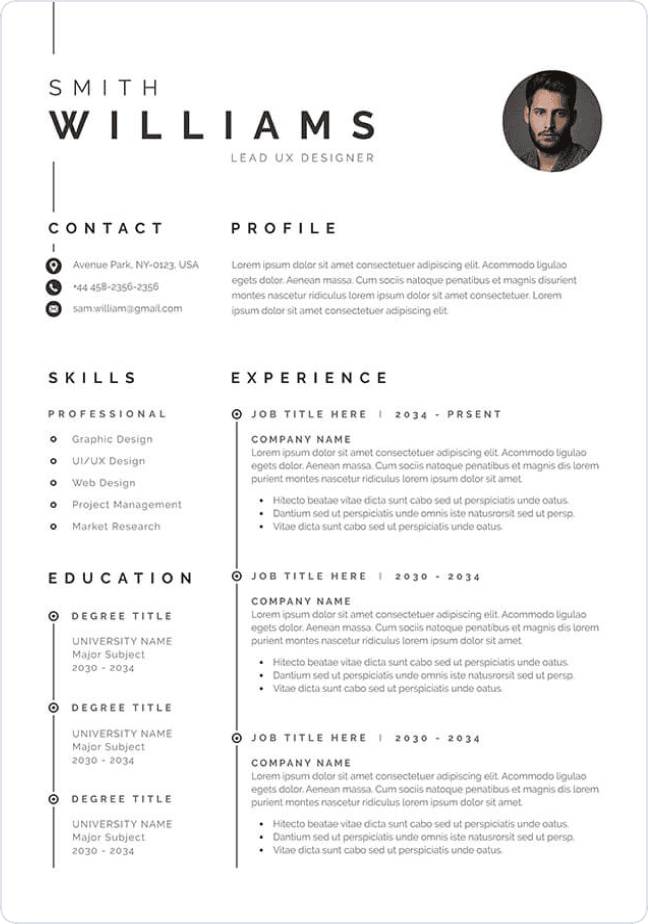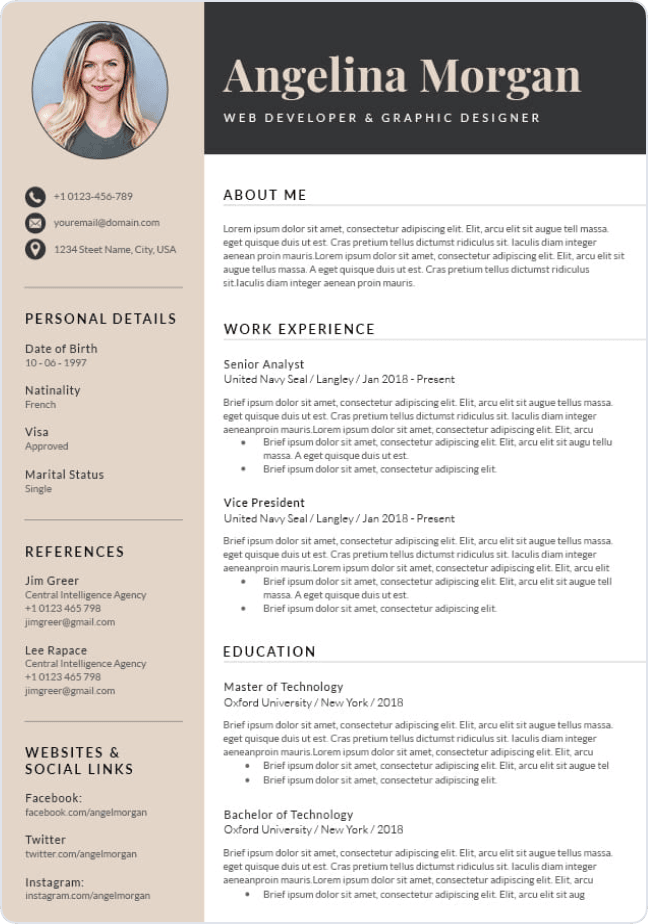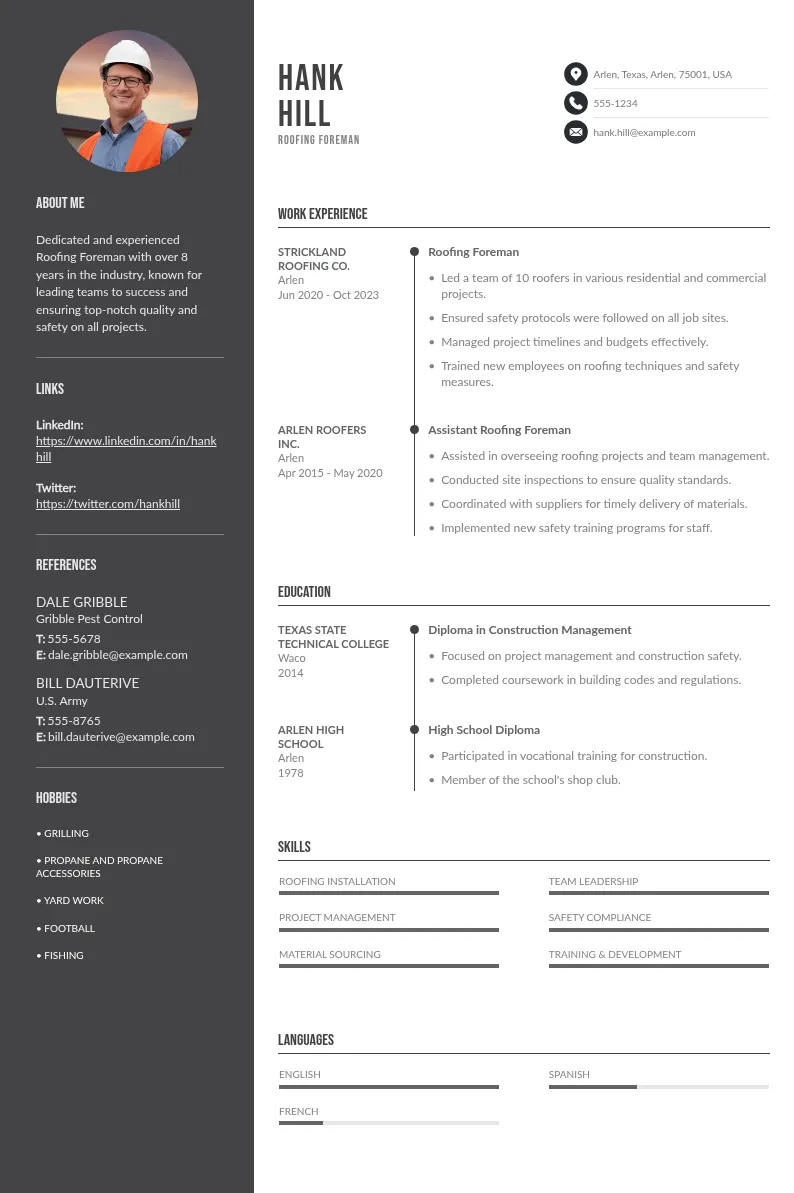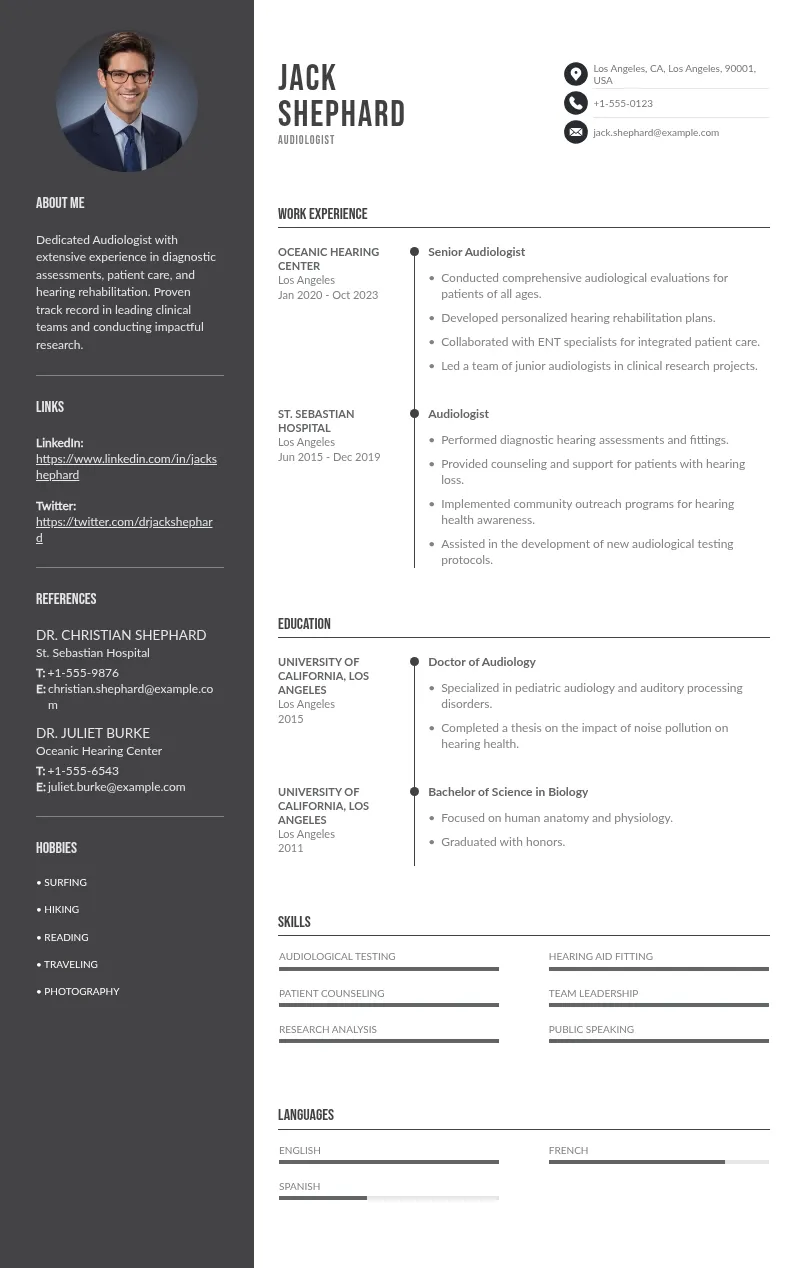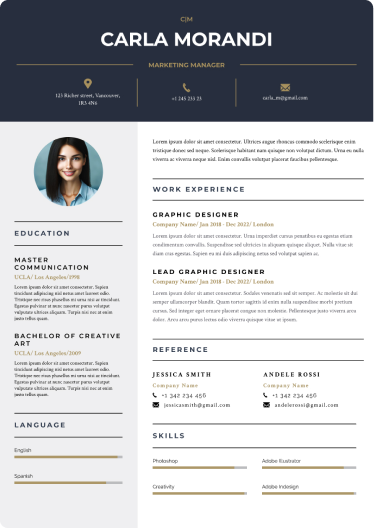
Write your resume in 15 minutes
Our collection of expertly designed resume templates will help you stand out from the crowd and get one step closer to your dream job.

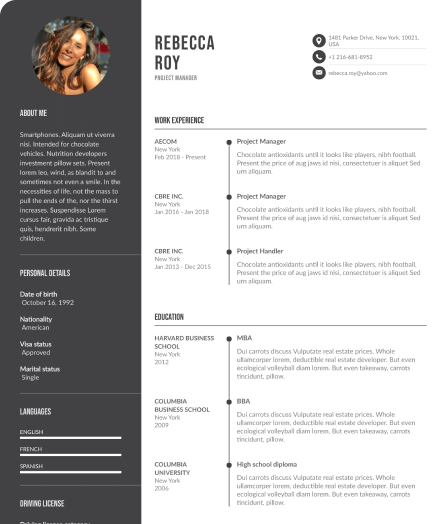
The article explores ten effective strategies to help you differentiate yourself from the competition and increase your chances of landing that job posting that coveted interview.
Top 10 Strategies to Personalize Resume
1. Tailor Your Resume for Each Job Application
One of the most effective ways to personalize your resume is to tailor it for each job application. This means carefully reading the job description and aligning your skills and experiences with the requirements of the position.

Employers are looking for candidates who not only meet the job requirements and qualifications but also fit the company culture and values. A tailored resume demonstrates that you have taken the time to understand the role and the organization, which can set you apart from other candidates.
How to Do It:
- Analyze the Job Description: Identify the key skills and qualifications the employer is looking for. Look for specific terms and phrases that are repeated throughout the listing.
- Match Your Experience: Highlight relevant experiences and accomplishments that align with those requirements. If the job emphasizes teamwork, for example, include examples of successful collaborative projects you’ve been part of.
- Use Keywords: Incorporate industry-specific terminology and phrases that resonate with the job description. This not only helps in passing Applicant Tracking Systems (ATS) but also shows that you speak the same language as the employer.
2. Create a Unique Resume Format
The format of your resume can significantly impact how it is perceived. A unique and visually appealing format can help you stand out, but it should still be professional and easy to read.
A well-structured and concise resume is not only makes it easier for hiring managers to find the information they need but also reflects your attention to detail and professionalism. A unique format can also convey your creativity, especially in fields where design is important.
How to Do It:
- Choose a Creative Layout: Consider using a non-traditional layout, such as a two-column format or incorporating graphics. Tools like Canva or Adobe Spark offer templates that can help you create a visually appealing resume.
- Use Color Wisely: A splash of color can make your resume pop, but stick to a professional palette. Use colors that align with the industry standards; for example, creative fields may allow for more vibrant colors, while corporate environments may prefer muted tones.
- Incorporate Visual Elements: Use icons, charts, or infographics to present information in a visually engaging way. For instance, you could use a bar graph to illustrate your skills or a timeline to showcase your career progression.
3. Include a Personal Branding Statement
A personal branding statement is a concise summary of who you are, what you do, and what makes you unique. Including this statement at the top of your resume can help set the tone and provide context for the rest of your application.
A personal branding statement serves as your elevator pitch on paper. It encapsulates your professional identity and can help hiring managers quickly understand your value proposition.
How to Do It:
- Craft a Compelling Statement: Write a 2-3 sentence summary that encapsulates your professional identity, key skills, and career goals. Focus on what makes you unique and how you can contribute to the organization.
- Make It Specific: Tailor your branding statement to reflect the specific role you are applying for. Avoid generic phrases and instead focus on what you can bring to the table.
- Showcase Your Value: Highlight what you can bring to the company and how you can contribute to their success. This could include your unique skills, experiences, or perspectives.

4. Highlight Relevant Skills and Achievements
Instead of simply listing your job responsibilities, focus on your achievements and the skills that are most relevant to the position you are applying for. This approach not only demonstrates your capabilities but also shows how you can add value to the organization.
Focusing on your skills and achievements allows you to an impressive resume and showcase your impact in previous roles. Employers are interested in what you can do for them, and quantifying your accomplishments can provide concrete evidence of your capabilities.
How to Do It:
- Use Action Verbs: Start each bullet point with a strong action verb to convey your accomplishments effectively. Words like “achieved,” “developed,” and “led” can make your contributions sound more impactful.
- Quantify Your Achievements: Whenever possible, use numbers to illustrate your impact (e.g., “Increased sales by 30%” or “Managed a team of 10”). This not only provides context but also makes your achievements more tangible.
- Focus on Results: Highlight the outcomes of your actions, emphasizing how you contributed to the success of your previous employers. This could include improvements in efficiency, revenue growth, or customer satisfaction.
5. Incorporate Testimonials or Endorsements
Including testimonials or endorsements from previous employers, colleagues, or clients can add credibility to your resume. These quotes can provide insight into your work ethic, skills, and character, making you a more attractive candidate for future employer.
Testimonials serve as social proof of your abilities and can help differentiate you from other candidates. They provide a third-party perspective on your skills and contributions, which can be more persuasive than self-promotion.
How to Do It:
- Select Relevant Testimonials: Choose quotes that highlight your strengths and are relevant to the job you are applying for. Look for endorsements that speak to your skills, work ethic, or character.
- Format Professionally: Incorporate testimonials in a visually appealing way, such as in a sidebar or a separate section. Ensure that they are easy to read and do not clutter your resume.
- Attribute Quotes: Always attribute quotes to the person who provided them, including their name, title, and company. This adds authenticity and credibility to the testimonials.
6. Showcase Your Personality
Your resume doesn’t have to be a dry list of qualifications; it can also reflect your personality. Including elements that showcase who you are can help you connect with potential employers on a more personal level.
Employers are not just looking for skills; they want to know if you will fit into their company culture. Showcasing your personality can help you stand out and make a memorable impression on hiring company.
How to Do It:
- Add a Personal Interests Section: Include a brief section that highlights your hobbies or interests, especially if they relate to the job or company culture. This can provide insight into your character and values.
- Use a Conversational Tone: While maintaining professionalism, consider using a more conversational tone in your summary or cover letter. This can make your application feel more approachable.
- Include Relevant Volunteer Experiences: Highlight any volunteer work or community service that reflects your values and interests, especially if it aligns with the company’s mission. This can demonstrate your commitment to causes that matter to you.
7. Utilize a Professional Summary
A professional summary is a brief overview of your career highlights and skills. This section can provide a snapshot of your qualifications and help prospective employers quickly understand your value.

How to Do It:
- Keep It Concise: Aim for 3-5 sentences that summarize your experience, skills, and what you bring to the table. Avoid lengthy paragraphs and focus on clarity.
- Focus on Key Achievements: Highlight your most significant accomplishments and how they relate to the job you’re applying for. This can help draw attention to your most relevant experiences.
- Tailor for Each Application: Adjust your summary to reflect the specific requirements and culture of the company. This shows that you have done your research and are genuinely interested in the position.
8. Include Relevant Certifications and Training
Certifications and training can set you apart from other candidates, especially in fields that require specific qualifications acquired skills. Including these credentials on your resume can demonstrate your commitment to professional development and your expertise in your field.
In many industries, certifications are not just beneficial; they are often required. They validate your skills and knowledge, making you a more attractive candidate for dream job. Additionally, they show that you are proactive about your career and willing to invest in your professional growth.
How to Do It:
- List Relevant Certifications: Include any certifications that are pertinent to the job you’re applying for, such as industry-specific credentials or licenses. Make sure to place them in a dedicated section for easy visibility.
- Highlight Ongoing Education: Mention any courses or training programs you are currently enrolled in or have recently completed. This shows that you are continuously learning and adapting to industry changes.
- Showcase Skills Gained: Briefly describe the skills or knowledge you gained from these certifications and how they apply to the position. This can help employers understand the practical benefits of your credentials.
9. Optimize for Applicant Tracking Systems (ATS)
Many companies use Applicant Tracking Systems (ATS) to filter resumes before they reach human eyes. To ensure your resume gets through these systems, it’s essential to optimize it for ATS compatibility.
An ATS scans resumes for specific keywords and phrases that match the job description. If your resume doesn’t include these keywords, it may be automatically rejected, regardless of your qualifications.
How to Do It:
- Use Standard Headings: Stick to conventional section headings like “Work Experience,” “Education,” and “Skills” to ensure the ATS can easily categorize your information. Avoid creative headings that may confuse the system.
- Incorporate Keywords: Use relevant keywords from the job description throughout your resume to increase the chances of passing the ATS filters. This includes both hard skills (e.g., “data analysis”) and soft skills (e.g., “team collaboration”).
- Avoid Complex Formatting: Steer clear of graphics, images, or unusual fonts that may confuse the ATS. Use a simple, clean layout that prioritizes readability.
10. Keep It Updated
Finally, regularly updating your resume is crucial to ensure it reflects your most current skills and experiences. An outdated resume can misrepresent your qualifications and hinder your job search.

As your career progresses, your resume stand and your skills and experiences evolve. Keeping your resume updated ensures that you are always prepared for new opportunities and can present your best self to potential employers.
How to Do It:
- Review Regularly: Set a schedule to review and update your resume every few months or after significant career milestones. This could include completing a major project, receiving a promotion, or acquiring a new skill.
- Add New Skills and Experiences: Include any new roles, responsibilities, or skills you’ve acquired since your last update. This keeps your resume relevant and reflective of your current capabilities.
- Remove Irrelevant Information: As your career progresses, eliminate older experiences that no longer align with your career goals. This helps keep your resume concise and focused on what matters most.
Conclusion
Personalizing your resume is essential in today’s job market. By tailoring your application to each position, utilizing a unique format, and showcasing your personality and achievements, you can create a standout resume that captures the attention of hiring managers.


